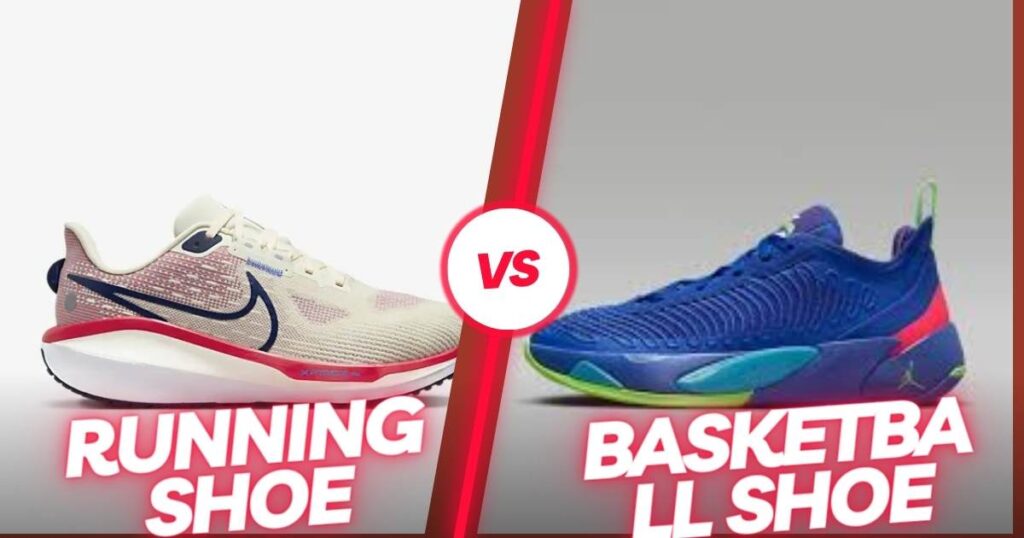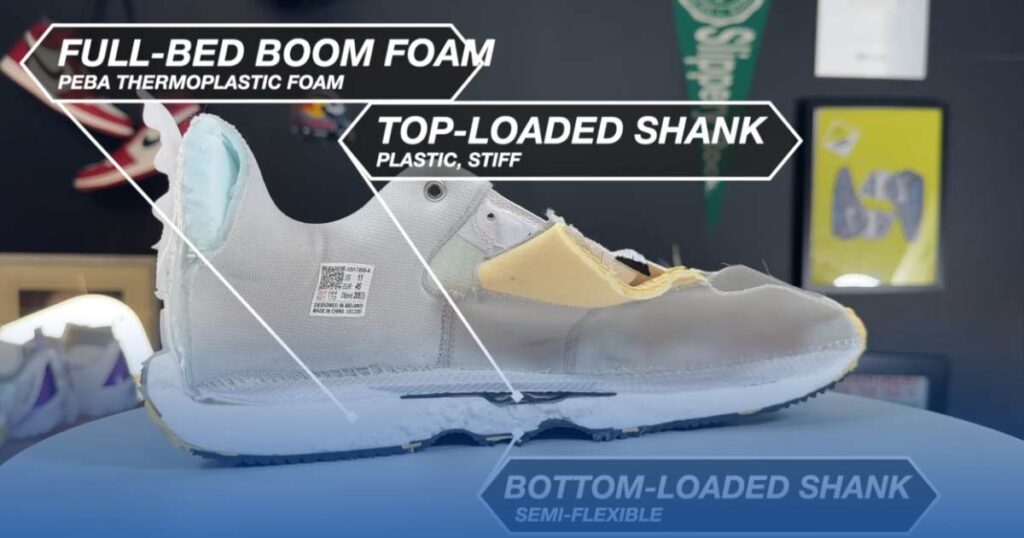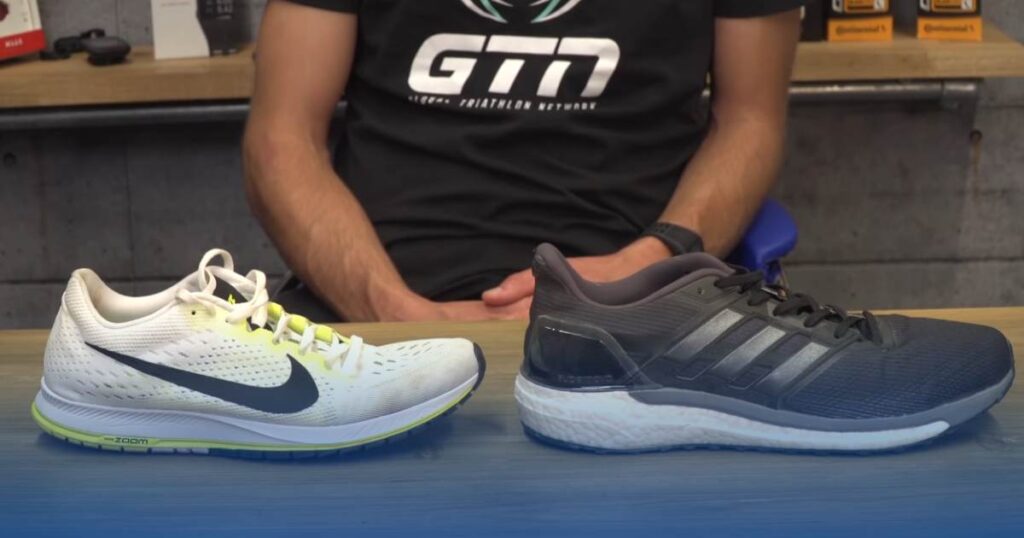Basketball shoes are not ideal for running due to their design differences and lack of necessary cushioning and support. However, they can be used for running in short bursts or casual settings.
Choosing the right footwear for running is crucial for both performance and injury prevention. Basketball shoes may not be the greatest choice for running activities, despite being particularly made for the needs of the basketball court. This is mainly due to the differences in design and features that cater to different movements and impact forces.
Running shoes typically prioritize cushioning, support, and flexibility, which is crucial for running long distances or on hard surfaces. In contrast, basketball shoes focus more on ankle support, stability, and quick lateral movements. While basketball shoes can be used for short bursts of running or in casual settings, they may not provide the necessary cushioning and support needed for longer distances or intense running workouts. It is important to choose footwear specifically designed for running to ensure optimal performance and reduce the risk of injuries.
Can You Run in Basketball Shoes?
Is it Safe and Effective to Run in Basketball Shoes?
Many individuals wonder whether it is safe and effective to use basketball shoes for running. The answer lies in the specific needs and goals of the runner. Running in basketball shoes is generally safe for casual runners who may not be pushing their limits. However, it’s essential to acknowledge the differences in design and functionality between these two types of footwear. Basketball shoes are not optimized for the repetitive linear motion of running. They are built for lateral movements, stability, and quick jumps, making them less ideal for the demands of running. For serious runners, running shoes are undoubtedly the preferred choice due to their design which minimizes the risk of injury and maximizes comfort during long distances.
Potential Benefits and Drawbacks of Using Basketball Shoes for Running
Using basketball shoes for running does have some potential benefits. The sturdy construction and ankle support can be advantageous for individuals with weak ankles or those who require extra support. However, these benefits may come at the cost of discomfort during extended runs. The drawbacks of using basketball shoes for running include the increased risk of discomfort, blisters, and potential injuries due to their design not catering to the repetitive forward motion of running. These shoes can also be heavier, which could lead to reduced speed and agility. In conclusion, while running in basketball shoes may have a few limited advantages for certain individuals, the drawbacks typically outweigh these benefits, making it a less optimal choice for running enthusiasts.
Personal Experiences and Expert Opinions
To shed light on the subject, personal experiences and expert opinions offer valuable insights. Many runners who have tried using basketball shoes for running report discomfort, pain, and a sense of instability during their runs. Podiatrists and sports medicine experts generally discourage the use of basketball shoes for running due to the mismatch in design and function. Running shoes are engineered to absorb impact and promote a natural running gait, while basketball shoes are optimized for lateral movements and jumping. These expert opinions underline the importance of choosing the right footwear designed specifically for running if you want to maximize your performance, comfort, and safety during runs.
Differences Between Basketball Shoes And Running Shoes

Basketball shoes and running shoes have key differences in cushioning, support, and traction. Cushioning in basketball shoes is designed to absorb impact during jumps and landings. Support in basketball shoes focuses on ankle and lateral stability for quick movements. Traction in basketball shoes is important to provide grip on the court surface.
On the other hand, running shoes are built with cushioning that supports the repetitive motion of running. They prioritize shock absorption and energy return to minimize impact on joints. Running shoes also have a lighter and more flexible construction for improved mobility.
While basketball shoes may be comfortable for short runs, they lack the necessary features for long-distance running. In conclusion, each style of shoe has a distinct function, thus it’s critical to select the appropriate footwear for various tasks.
Basketball Shoes: Designed for Quick Movements and Jumping
Basketball shoes are meticulously crafted to cater to the specific demands of the sport. They often feature a high-top design, providing ankle support during quick lateral movements and jumps. The outsoles are engineered for grip and traction on the basketball court, with a pattern optimized for hardwood surfaces. This design ensures that basketball players can make sharp cuts, pivot swiftly, and stop on a dime. The cushioning in basketball shoes is usually concentrated in the forefoot and heel areas, aiming to provide responsive shock absorption during jumps. However, the weight of these shoes tends to be on the heavier side, reflecting the need for stability and protection on the court.
Running Shoes: Tailored for Endurance and Forward Motion
In contrast, running shoes are engineered with the primary goal of facilitating forward motion and minimizing impact. They typically have a lower-profile design, focusing on lightweight construction to enhance speed and endurance. The outsoles of running shoes have a different tread pattern optimized for various terrains, providing a balance between grip and smooth transitions. Running shoes are known for their extensive cushioning throughout the sole, absorbing shock with every stride to protect the joints. This cushioning is often evenly distributed from heel to toe, ensuring that runners experience comfort and reduced fatigue during extended runs. Weight is a significant consideration, and running shoes are designed to be as lightweight as possible to promote agility and minimize energy expenditure.
Key Differences: Cushioning, Support, and Weight
The most prominent differences between basketball and running shoes revolve around cushioning, support, and weight. Basketball shoes prioritize responsive cushioning in the forefoot and heel to support high-impact jumps and quick lateral movements, whereas running shoes offer even cushioning throughout to promote endurance and comfort during forward motion. The ankle support found in basketball shoes is essential for lateral stability but may limit natural ankle movement, while running shoes have a lower-profile design that encourages a more natural gait. Moreover, the weight disparity is significant, with basketball shoes being heavier to provide stability and protection, while running shoes are lighter to optimize running performance.
| Aspect | Basketball Shoes | Running Shoes |
|---|---|---|
| Cushioning | Absorbs impact during jumps and landings, mainly in forefoot and heel areas. | Evenly cushions sole for reduced joint impact during forward motion. |
| Support | Prioritizes ankle and lateral stability, often high-top design. | Supports natural gait, usually lower-profile. |
| Traction | Optimized for basketball courts, provides grip on hardwood surfaces. | Designed for various terrains, balancing grip and smooth transitions. |
| Construction | Heavier for stability and protection on the court. | Lighter and flexible for improved running performance. |
| Function | Enhances agility, stability for sharp cuts and jumps. | Promotes comfort, endurance for extended running. |
| Design | Often high-top for ankle support during lateral movements. | Typically lower-profile for natural gait and reduced weight. |
Risks of Running in Basketball Shoes

Potential Risks and Injuries Associated with Using Basketball Shoes for Running
Running in basketball shoes can result in injuries. The primary risk is ankle injuries. Basketball shoes limit ankle mobility, increasing the risk of twists and sprains.
Insufficient cushioning is another concern. Basketball shoes don’t provide even cushioning throughout, potentially leading to discomfort, shin splints, and knee pain during runs.
Examples of Injuries and Discomfort Arising from Improper Footwear
Running in basketball shoes can cause blisters due to friction. Blisters are painful and can hinder your ability to run comfortably.Inadequate arch support may result in arch pain or plantar fasciitis, a condition characterized by heel pain.
Lack of cushioning can increase the risk of stress fractures in the shins or knees, stemming from the continuous pounding on hard surfaces.
Pros And Cons Of Using Basketball Shoes For Running
Basketball shoes can be used for running, but they have their pros and cons. One of the pros is the ankle support they provide, reducing the risk of injury. Another advantage is their durability, allowing them to withstand the demands of running.
Moreover, basketball shoes are versatile and suitable for both outdoor and indoor activities. There are certain disadvantages to think about, though. Firstly, they tend to be heavier compared to dedicated running shoes, which may affect performance. Additionally, basketball shoes have limited flexibility, potentially hindering natural foot movement.
Furthermore, the breathability of these shoes is often lower, causing discomfort during longer runs. Basketball shoes may be used for jogging, but it’s vital to assess the benefits and drawbacks before deciding. Ultimately, choosing the right footwear depends on individual preferences, foot structure, and running style.
Basketball Shoes: Designed for Quick Movements and Jumping

High-Top Design for Enhanced Ankle Support
Basketball shoes are meticulously engineered to cater to the specific demands of the sport. One distinguishing feature is their high-top design, which offers enhanced ankle support. This design is crucial for basketball players as it provides stability and protection during quick lateral movements and jumps. The higher cut of the shoe helps prevent ankle injuries by restricting excessive movement. However, for runners, this design can have drawbacks. It may limit the natural range of motion required for running, potentially increasing the risk of sprained or twisted ankles. Runners typically need more freedom of movement around the ankle, which is why low-top or mid-top shoes are preferred for running, as they provide a balance between support and mobility.
Outsoles Optimized for Traction and Grip
The outsoles of basketball shoes are a vital component, as they are designed for optimal grip and traction on the basketball court. The tread pattern is tailored to hardwood surfaces, ensuring that basketball players can make sharp cuts, pivot swiftly, and stop quickly. This design, while excellent for the demands of basketball, is less than ideal for running on various terrains. It can create a sensation of dragging or discomfort for runners, as the outsole pattern is not optimized for the repetitive linear motion of running. In contrast, running shoes feature outsoles with a different tread pattern, offering a balance between grip and smooth transitions to support forward motion. This difference underscores why basketball shoes may not be the best choice for running, especially on uneven surfaces or trails.
Cushioning Focused on the Forefoot and Heel
Basketball shoes prioritize responsive cushioning, with an emphasis on the forefoot and heel areas. This design is intended to provide shock absorption during high-impact jumps and quick lateral movements. While it is effective for basketball players who need to protect their joints during leaps and landings, it doesn’t align with the requirements of running. Runners require cushioning that is evenly distributed from heel to toe to absorb the repetitive shock of each stride, ensuring comfort and reduced fatigue over extended distances. The concentrated cushioning in basketball shoes can lead to discomfort and pain during runs, particularly in the midfoot area. This is a crucial distinction that runners should consider when choosing their footwear, as inadequate cushioning can lead to injuries and discomfort in the long run.
Factors To Consider When Choosing The Right Shoe For Running
There are several things to take into account while choosing the best shoe for running. Choose your running style first, whether it be brisk walking, long-distance running, or sprinting. The next thing to think about is if your foot pronation is excessive, under, or neutral.
In addition, think about the terrain you’ll be running on, such as road, trail, or track. Lastly, don’t forget to consider your personal preference and comfort when choosing a shoe. You may choose the ideal running shoe that meets your demands by taking all of these variables into account.
Tips For Using Basketball Shoes For Running
Running in basketball shoes is possible, but there are certain considerations. First, warm up and stretch your muscles. This helps prevent injuries and prepares your body for the activity. Secondly, make a gradual transition from basketball to running shoes.
Start with shorter distances and slowly increase your mileage. This allows your feet and muscles to adjust to the differences in shoe design. Lastly, proper maintenance is crucial. Keep your shoes clean and dry to prevent odor and prolong their lifespan.
Regularly check for any signs of wear and tear, and replace them as needed. Remember, using basketball shoes for running can be convenient, but it’s important to take these precautions for optimal performance and safety.
are basketball shoes good for running on treadmill
When it comes to running on a treadmill, basketball shoes may not be the ideal choice. While basketball shoes are designed to provide support and cushioning for quick lateral movements on the basketball court, they may not offer the same level of comfort and stability needed for running on a treadmill. Running shoes are specifically designed with features such as lightweight construction, cushioning, and flexibility to absorb impact and provide optimal support for forward motion. It is recommended to choose running shoes that are specifically designed for running activities to ensure a comfortable and injury-free workout on a treadmill.
Choosing the Right Running Shoes

Guidance on Selecting Appropriate Running Shoes
Selecting the right running shoes is crucial for a comfortable and injury-free running experience. To make an informed choice, consider the following guidance. First, assess your running style and the type of terrain you’ll be running on. Different running shoes are designed for road running, trail running, or track running, and choosing the one that matches your typical environment is essential.
Next, determine your foot type. Understanding whether you have high arches, flat feet, or neutral arches is critical. This knowledge helps you select shoes that provide the right level of arch support, which is essential for preventing discomfort and potential injuries. Running stores often have experts who can analyze your gait and recommend the right shoes based on your foot type.
Factors Influencing Your Choice: Foot Type, Shoe Fit, and Running Goals
Consider your specific foot type when selecting running shoes. Those with high arches should look for shoes with ample cushioning to absorb impact and promote stability. Runners with flat feet may benefit from shoes that offer more arch support and motion control to prevent overpronation. If you have neutral arches, you have more flexibility in your shoe choice, but it’s still essential to find a comfortable fit.
Shoe fit is another critical factor. Running shoes should provide a snug fit without being too tight. Ensure that there’s enough room in the toe box to prevent blisters and discomfort. The heel should feel secure, and the midfoot should be well-supported. It’s advisable to try on several pairs and walk around in them to find the most comfortable fit.
Finally, your running goals should influence your choice of shoes. Are you training for a marathon, looking for lightweight options for speed, or seeking maximum cushioning for long-distance comfort? Your specific running goals can help you narrow down the features you need in your running shoes.
Frequently Asked Questions For Are Basketball Shoes Good For Running
Are Basketball Shoes Suitable For Running Long Distances?
No, basketball shoes are designed for quick lateral movements and provide stabilization for basketball players. They lack the necessary cushioning and support for running long distances, which can lead to discomfort and injuries. It is best to choose running shoes specifically designed for running activities.
Can Basketball Shoes Be Used For Casual Running?
Yes, basketball shoes can be used for casual running if the distances are short and the intensity is low.They might not, however, offer the same degree of support and comfort as running shoes. For longer runs or more intensive workouts, it is recommended to invest in a pair of dedicated running shoes.
Why Are Basketball Shoes Not Ideal For Running?
Basketball shoes are not ideal for running because they are designed with different features. They prioritize ankle support and stability for quick lateral movements while running shoes focus on cushioning and shock absorption to provide a smooth and comfortable running experience.
Conclusion
Even while basketball shoes might not be the best option for running, they can nevertheless offer some comfort and support. While they may lack certain features specifically designed for running, their cushioning and stability can certainly make them suitable for shorter runs or casual jogging.
However, for serious runners or those with specific foot conditions, investing in proper running shoes is highly recommended.It’s crucial to keep in mind that basketball shoes are made to give grip and ankle support on the court, which may not be as advantageous for jogging a long distance.


